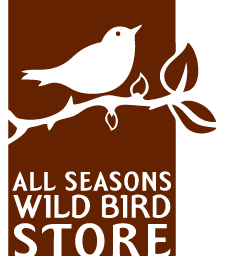This article is from our Bird’s-Eye View Newsletter Archives: May/June 2011

By White Bear Lake Manager Bob Ellis
One of the most striking songbirds to visit backyards is the oriole. The vivid orange and black coloring of a male Baltimore oriole is unmistakable and dramatic. While both sexes display a white wing bar, the female’s palette is more subdued, with a dull yellow body and grayish-brown wings. Young orioles appear similar to females in color. Juvenile males molt into their adult orange and black while wintering in Central America. You may hear orioles before you see them: the flute-like call of the Baltimore oriole is clear and loud.
Oriole nesting and habitat
Baltimore orioles make their summer home in broadleaf woodlands and forest edges over all of Minnesota—in fact, over most of the eastern United States. A Baltimore oriole’s nest is quite distinctive; the female weaves a pouch from long strands of plant material on a high branch, very often in a cottonwood tree, here in Minnesota. She then lines it with grass, feathers or even animal fur. Orioles will utilize soft nesting material such as yarn and cotton if offered.
Attracting orioles
Orioles eat insects and fruit and can be attracted to feeders that offer nectar, mealworms, grape jelly, or fruit—especially oranges. They’re sometimes spotted feeding from hummingbird feeders if they can manage a grip, but prefer oriole-specific nectar feeders that feature larger ports and roomier perches.
Grape jelly or orange halves are good offerings during spring and fall migration. While orioles will continue to visit a jelly feeder throughout the summer, mealworms are attractive to oriole parents; their growing young need the protein. Once the young can fly, the parents will bring them right to the food, which is much easier than the constant ferrying of food the parents do up to this point. Use a dish feeder for jelly or mealworms—or, better yet, both at once—to make a particularly versatile and successful oriole feeder.
Identifying oriole species
You may encounter Orchard orioles in open wooded areas in southern and western Minnesota. Orchard orioles are smaller, have a deep chestnut-red body and sport a black hood and wings. Another oriole species is the western Bullock’s oriole. These birds look similar to Baltimore orioles. In fact, older field guides grouped the two species together with the title of “northern oriole.”
Classifying orioles
Orioles are in a group of birds known as icterids. It may surprise you that this group also includes birds that most backyard birders would rather not see—blackbirds, grackles and cowbirds. Compare the outline of an oriole to a red-winged blackbird. You’re likely to notice the family resemblance.

